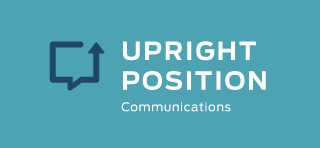What is the PR Triangle of Dysfunction?
Upright Position Communications CEO Paul Wilke says this triangle is scarier than the infamous Bermuda Triangle south of Florida, where many go in and never come out. That’s pretty scary! But the good news is this triangle isn’t nearly as mysterious, and there are things we can do to stay balanced and away from the black hole of poor communications.
The PR agency, the PR client and the journalist create each point of the triangle. They all speak different languages, and clients and journalists have unique needs that place the PR agency in the middle, trying to please everyone. Paul has been on all three sides of the triangle and understands each perspective.
The journalist has a story to tell. They want something newsworthy. See our post and video all about what makes something newsworthy here. The client wants to promote their business, new product, influencer… And the PR team juggles the message to find matches between clients’ stories and journalists’ interests. Each side of the triangle has its own goals, creating a structure that lends itself to dysfunction and presents challenges to overcome.
Paul shares his story as the only PR person in a large company where his team members and CEO didn’t completely understand the language of PR. He had a fantastic PR firm, and together, they had to tell a new story to journalists who didn’t know, understand or care what the company did. The PR firm was as much therapist as provider of PR counsel, working to smooth all the edges to help everyone begin to understand each other so the story could be told to benefit everyone.
How do you know you’re heading toward dysfunction as a client?
If you’re seeking PR, here are some warning signs that you’re entering the dysfunction triangle.
- Higher-ups in your company don’t understand PR. This lack of clarity can lead to unreasonable expectations and requests that PR agencies can’t accommodate because no journalists are interested in sharing the client’s message.
- If you work with an agency, are you receiving the deliverables and effort you need from them? Are they the “therapist” you need to help you understand expectations and best practices? Are they supporting you and able to convey your company’s message?
- Are you considering all sides of the triangle on equal tiers? Journalists, clients and agencies all deserve to be respected, and everyone must recognize that all groups are equally important.
Don’t panic if your PR agency says your message isn’t quite ready for prime time. There are always options to get PR messages and positive communications out, regardless of the topic, but that might mean working with your PR agency on messaging you can control without expectations of coverage from journalists.
Examples of owned public relations include:
- writing blog posts for the company website,
- creating bylined content,
- and making videos with your experts.
All these tactics help make your message clear and frame it the way you want. Developing owned messages helps set the stage for others to share your story and makes it easier to reach out to journalists when your message is already placed everywhere you can.
And as PR people, there are three things we can do to help balance the triangle.
First, listen to both your client and journalists. By listening, you hear what everyone’s concerns are. And recognize that sometimes you’re not there to solve the problem but just to listen.
Next, fight the instinct to people-please. Don’t tell people what they want to hear when you’d be more helpful in sharing what they need to hear.
Finally, kick the tires. Ask what clients are looking to achieve. Questions help you uncover clients’ aspirations and allow you to provide the expert advice they need from you. Find what is newsworthy with them and keep journalists from blocking your pitches when you try to work with requests you know aren’t fully developed.
Every group plays a part.
It’s easy for each side to point fingers, but the issues leading to dysfunction are firmly in all camps. While the triangle doesn’t have to exist, recognize when it does and initiate clear and honest communication. It can be hard to deliver, hard to hear and even harder to accept, but when we all get on equal ground and understand where needs fall, everyone can start to move in a unified direction.
For more tips on PR, please check out all the videos on our YouTube channel and blog.
We’re here for a quick brainstorm, special projects and all things PR and communications related to businesses large and small. Contact us at uptake@uprightcomms.com if you’d like to talk PR and see how we can help your organization shine.
